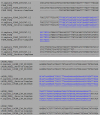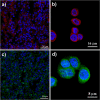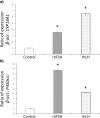Evidence for expression and functionality of FSH and LH/hCG receptors in human endometrium
- PMID: 29974367
- PMCID: PMC6133814
- DOI: 10.1007/s10815-018-1248-8
Evidence for expression and functionality of FSH and LH/hCG receptors in human endometrium
Abstract
Purpose: Follicle-stimulating hormone (FSH) and luteinizing hormone (LH) mediate intracellular functions by binding their specific protein G-coupled gonadotrophin receptor, respectively FSH receptor (FSHR) and LH/choriogonadotrophin receptor (LHCGR). Whereas the expression of FSHR and LHCGR in mammals was considered gonad-specific and cell-specific, studies identified gonadotrophin receptors in human female extragonadal reproductive tissues. This study aims to demonstrate that gonadotrophin receptors are expressed in endometrium and mediates intracellular functions.
Methods: Collected endometria (n = 12) from healthy patients (mean age of 36 ± 6) were primary cultured for 24 h. The presence of gonadotrophin receptors was evaluated by RT-PCR followed by the sequencing of the resulted amplicons and by immunohistochemistry in original samples. Endometrial primary cultures were treated with increasing concentration (range 0-100 ng/ml) of either recombinant human LH (rhLH) or recombinant human FSH (rhFSH). Endometria controls had gonadotrophin replaced by the same volume of the culture medium. In gonadotrophin-treated samples, it was evaluated the intracellular cyclic adenosine monophosphate (cAMP) content by enzymatic immunoassay and the expression of steroidogenic genes by reverse transcriptase-quantitative polymerase chain reaction (RT-qPCR).
Results: The sequencing of the RT-PCR amplicons confirmed the presence of both gonadotrophin receptors and immunohistochemistry localized them on the membrane of endometrial glands cells throughout the glandular epithelium. The gonadotrophin-receptor complex was able to increase the intracellular cAMP in a dose-response and time-course manner and to induce steroidogenic genes expression.
Conclusion: This study demonstrates that both gonadotrophin receptors are expressed along the glandular epithelium of endometria and they mediate the effects of gonadotrophins on intracellular functions.
Keywords: Endometrium; FSHR; Gonadotrophin; LHCGR; Steroidogenic genes.
Conflict of interest statement
Ethical approval
All procedures performed in studies involving human participants were in accordance with the ethical standards of the institutional and/or national research committee and with the 1964 Helsinki declaration and its later amendments or comparable ethical standards.
Informed consent
Informed consent was obtained from all individual participants included in the study.
Conflict of interest
The authors declare that they have no conflict of interest.
Figures








Similar articles
-
Gonadotrophins modulate cell death-related genes expression in human endometrium.Horm Mol Biol Clin Investig. 2020 Apr 17;41(2). doi: 10.1515/hmbci-2019-0074. Horm Mol Biol Clin Investig. 2020. PMID: 32304301
-
Regulation of endometrial cancer cell growth by luteinizing hormone (LH) and follicle stimulating hormone (FSH).Br J Cancer. 2000 Dec;83(12):1730-4. doi: 10.1054/bjoc.2000.1507. Br J Cancer. 2000. PMID: 11104573 Free PMC article.
-
The C-terminal third of the human luteinizing hormone (LH) receptor is important for inositol phosphate release: analysis using chimeric human LH/follicle-stimulating hormone receptors.Mol Endocrinol. 1996 Sep;10(9):1127-37. doi: 10.1210/mend.10.9.8885247. Mol Endocrinol. 1996. PMID: 8885247
-
Genetic variants of gonadotrophins and their receptors: Impact on the diagnosis and management of the infertile patient.Best Pract Res Clin Endocrinol Metab. 2022 Jan;36(1):101596. doi: 10.1016/j.beem.2021.101596. Epub 2021 Nov 10. Best Pract Res Clin Endocrinol Metab. 2022. PMID: 34802912 Review.
-
Bioassays of gonadotropins based on cloned receptors.Mol Cell Endocrinol. 1996 Dec 20;125(1-2):151-9. doi: 10.1016/s0303-7207(96)03946-9. Mol Cell Endocrinol. 1996. PMID: 9027353 Review.
Cited by
-
In vitro fertilization cycle and embryo transfer outcomes in oligoanovulatory patients with hypothalamic hypogonadism vs. polycystic ovary syndrome and compared with normo-ovulatory patients.F S Rep. 2022 Jun 17;3(3):237-245. doi: 10.1016/j.xfre.2022.06.003. eCollection 2022 Sep. F S Rep. 2022. PMID: 36212560 Free PMC article.
-
Gonadotropin-Releasing Hormone (GnRH) Agonist Protocol Improves Pregnancy Outcomes During In Vitro Fertilization (IVF) and Intracytoplasmic Sperm Injection (ICSI) Treatment in Young Infertile Women: A Retrospective Study.Cureus. 2024 Jun 2;16(6):e61554. doi: 10.7759/cureus.61554. eCollection 2024 Jun. Cureus. 2024. PMID: 38962592 Free PMC article.
-
Effect of intrauterine injection of human chorionic gonadotropin before frozen-thawed embryo transfer on pregnancy outcomes in women with endometriosis.J Int Med Res. 2019 Jul;47(7):2873-2880. doi: 10.1177/0300060519848928. Epub 2019 May 23. J Int Med Res. 2019. PMID: 31119991 Free PMC article.
-
Association between serum LH levels on hCG trigger day and live birth rate after fresh embryo transfer with GnRH antagonist regimen in different populations.Front Endocrinol (Lausanne). 2023 Jul 5;14:1191827. doi: 10.3389/fendo.2023.1191827. eCollection 2023. Front Endocrinol (Lausanne). 2023. PMID: 37476498 Free PMC article.
-
Serum LH levels before progesterone administration significantly affect pregnancy outcomes in hormone replacement therapy-frozen-thawed embryo transfer cycles.J Ovarian Res. 2025 Jul 19;18(1):158. doi: 10.1186/s13048-025-01743-x. J Ovarian Res. 2025. PMID: 40684241 Free PMC article.
References
-
- Vaitukaitis JL, Ross GT, Braunstein GD, Rayford PL. Gonadotropins and their subunits: basic and clinical studies. Recent Prog Horm Res. 1976;32:289–331. - PubMed
-
- Fritz IB. Sites of action of androgens and follicle-stimulating hormone on cells of the seminiferous tubule. In: Litwack G, editor. Biochemical actions of hormones. New York: Academic; 1978. pp. 249–281.
-
- Kangasniemi M, Kaipia A, Toppari J, Perheentupa A, Huhtaniemi I, Parvinen M. Cellular regulation of follicle-stimulating hormone (FSH) binding in rat seminiferous tubules. J Androl. 1990;11(4):336–343. - PubMed
-
- Dankbar B, Brinkworth MH, Schlatt S, Weinbauer GF, Nieschlag E, Gromoll J. Ubiquitous expression of the androgen receptor and testis-specific expression of the FSH receptor in the cynomolgus monkey (Macaca fascicularis) revealed by a ribonuclease protection assay. J Steroid Biochem Mol Biol. 1995;55(1):35–41. doi: 10.1016/0960-0760(95)00148-S. - DOI - PubMed
MeSH terms
Substances
LinkOut - more resources
Full Text Sources
Other Literature Sources

